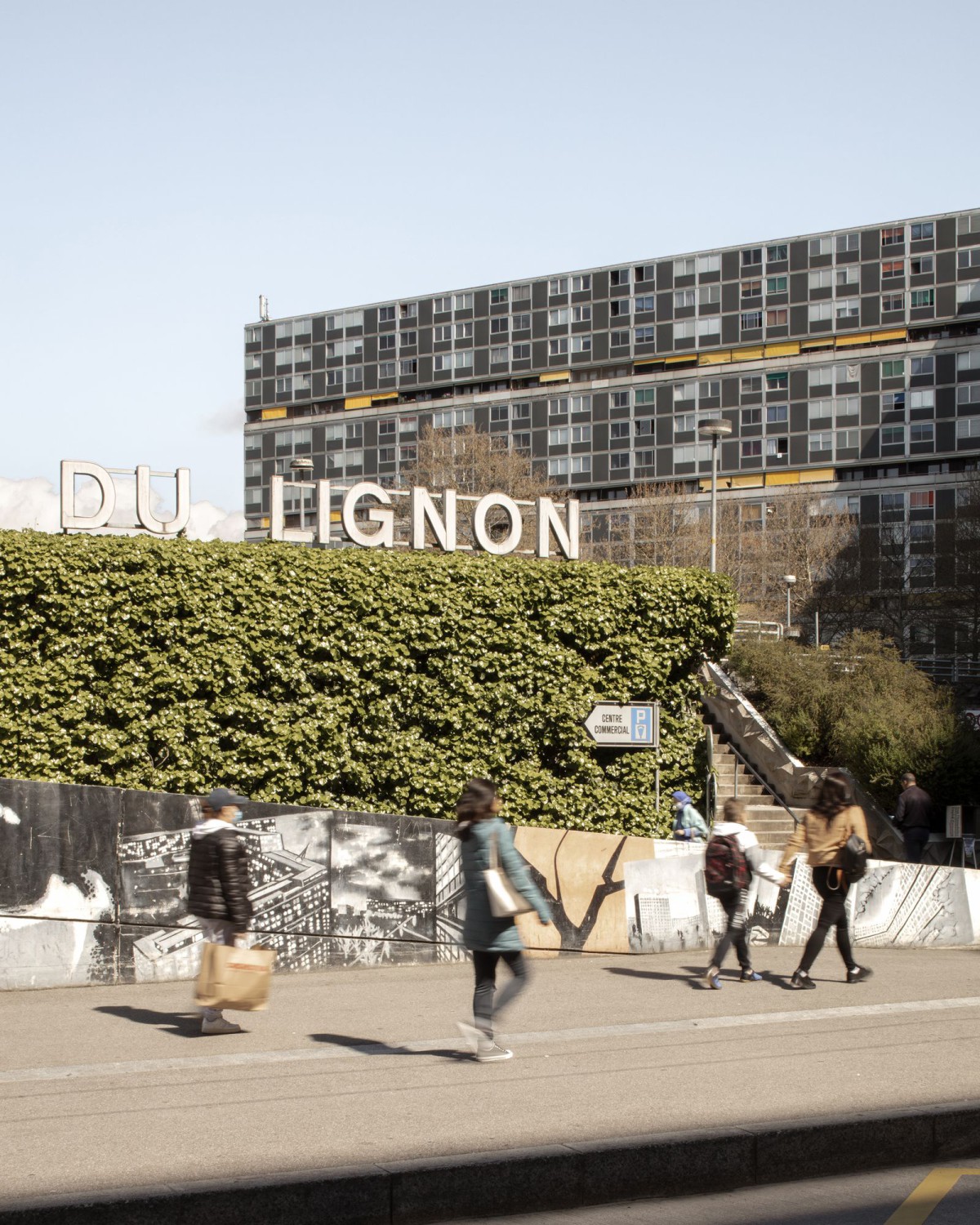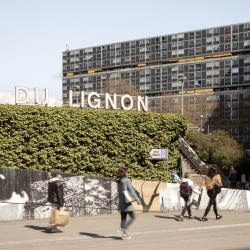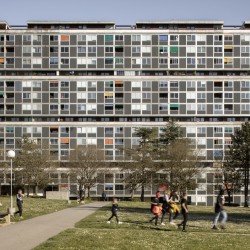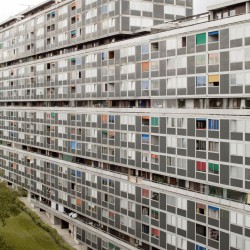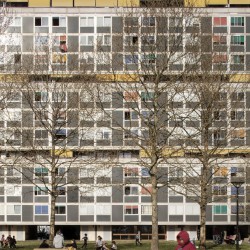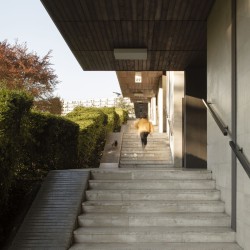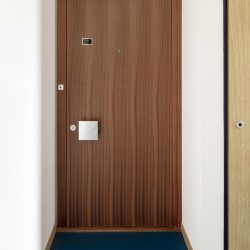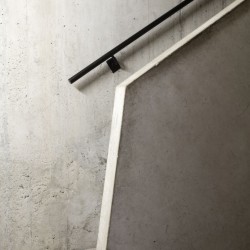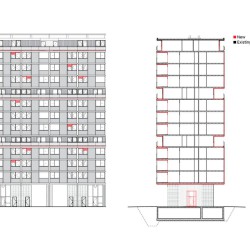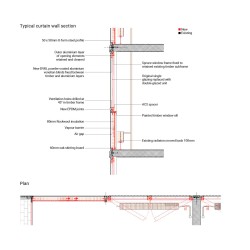Jaccaud Spicher Architectes Associés . photos: © Paola Corsini . + AJ
Geneva architecture practice Jaccaud Spicher Architectes Associés has led a phased renovation of the listed, modernist housing complex Le Lignon; restoring its original identity and retaining its patina and original materials, while reconditioning the façades and glazing to improve the thermal performance as it enters its next phase of life. Over 11 years, this high-tech, invisible cloak of a project has methodically replaced ageing elements of the original residential buildings with rigorously tested new systems and materials, and sensitively restored interior features, honouring the original craftsmanship.
Built between 1963 and 1971 by the architects Georges Addor, Dominique Julliard, Louis Payot and Jacques Bolliger, Le Lignon is the largest residential complex in Switzerland, a satellite city boasting a total of 2,780 individual dwellings alongside a school, shopping arcade, medical centre, church, recreational space and urban farm with allotments. It is located on a sharply sloping site on the banks of the Rhône on the western edge of the city of Geneva. Built to address a housing shortage in the 1960s and early 70s, it continues to accommodate approximately 7,000 residents (a significant portion of Vernier’s 34,000 population), to this day.
The plan is articulated into three main masses: two tower blocks of 26 and 30 storeys to the south of the site, and a 12-18 storey linear ‘bar’ building more than a kilometre long, that snakes along the cascading topography of the site. All apartments are dual aspect with views of the landscape, the Rhône, and the Alps and Jura beyond.
Since its completion in 1971 it has housed residents across a range of housing tenures: state subsidised social housing, free market rental and private ownership. Social housing is located in the eastern part of the bar building and is identical in spatial arrangements and material specification and fittings as the market sale apartments. The social diversity that is generated has ensured a long-lasting coherence for the entire neighborhood – a thriving community which includes three generations of families and residents of all ages and socio- economic backgrounds.
This extensive refurbishment focused on the fabric of the buildings and entrances and walkways, upgrading the original buildings to ensure that the high-density housing exemplar remains fit for purpose for a further 50 years.
The original buildings were constructed using prefabricated concrete structural units, and an aluminium and timber curtain walling system for the façades. It was the curtain wall that began to deteriorate by 2002, prompting the Geneva heritage authorities (OPS) to start a process to ensure the protection of the building, which led to Le Lignon’s official listing in 2009.
JSAA was commissioned in 2010 by a consortium of eight of Le Lignon’s main stakeholders – including pension funds and housing associations – to rehabilitate large sections of the building, improving its comfort and energy efficiency to meet Switzerland’s new thermal performance building standards.
Despite the complexity of ownership, the consortium was driven by a sense of responsibility to maintain the unity and identity of Le Lignon, appointing the practice to oversee a holistic and phased renovation framework to reinforce the unity between the different parts, which had diminished as a result of ad-hoc intermittent maintenance.
The practice was asked to devise a strategy in response to a research study into the required repairs undertaken by TSAM laboratory of the Federal Institute of Technology, Lausanne (EPFL), under the direction of Franz Graf and Giulia Marino. Several options were analysed and a prototypical approach identified.
The key elements of the renovation include conserving the outer aluminium and glass layers of the curtain wall façades and replacing the inner timber layers of the interior.
In 2012, a ‘prototype’ building comprising 24 apartments, No. 49 Avenue du Lignon, was refurbished, functioning as a trial to resolve details and identify suitable materials, and to measure performance over a duration of 24 months. The works included replacing the inner timber layer of the façade with double glazing and new frames, while the exterior aluminium skin and glazing were retained and cleaned. This approach would be applied to all units refurbished across the estate. In addition, works were carried out on the interior, replacing the glazing in room partitions and overhauling the original Formica kitchens with a scheme of metal cupboards and splashbacks, a fit-out which would be applied to vacant units between tenancies at the time of renovation. The building entrance was also refurbished with the installation of a new inner porch door to provide a thermal boundary to the residential block.
In parallel with this prototype, planning permission was obtained for the renovation of the entire complex, authorising the owners of each individual dwelling to instruct works on their properties. JSAA then followed through with a phased renovation of large segments of the bar building and the smaller tower building, in close cooperation with building owners and the Comité Central du Lignon (which oversees the maintenance of the entire complex), grouping residents by stairwells to ensure that the conservation process could be undertaken without causing disruption to life on the estate.
Throughout the renovation residents have been able to remain in their homes, and all residents have benefitted from reduced maintenance costs and savings on energy bills, which is supplied through a centralised district heating system. Geneva’s LDTR law prohibits the passing on of costs during the first three years, which means that tenants can enjoy the improved level of comfort without facing an upsurge in rent.
Construction began in earnest in 2017 with the instruction of the renovation of the linear bar building and the smaller tower block of 26 storeys. These renovations will complete in June 2021.
_
Réalisée entre 1963 et 1971 par les architectes Georges Addor, Dominique Julliard, Louis Payot et Jacques Bolliger, la Cité du Lignon est le plus grand complexe d’habitation de Suisse. Cet ensemble monumental est composé de 84 allées, pour un total de 2’780 appartements. Le plan masse articule trois corps bâtis ; deux tours au sud de la cité et un bâtiment d’un seul tenant qui se développe en se pliant sur plus d’un kilomètre, avec une hauteur qui varie entre 12 et 18 étages selon la topographie du terrain. Ce système d’implantation évite les vis-à-vis et favorise l’ensoleillement grâce aux typologies traversantes notamment. Suite à une demande datant de 2002, un plan de site est adopté le 13 mai 2009 pour les bâtiments de logements, l’école et l’église. Cette mesure permet d’assurer la protection de l’ensemble et d’en assurer la rénovation de manière structurée. Si l’ensemble du Lignon conserve une remarquable homogénéité plus de 50 ans après sa construction, grâce à un système constructif rationnel et une mise en œuvre de qualité, des travaux importants sont requis afin de répondre au besoin de mise en conformité avec les normes énergétiques contemporaines et d’assurer la pérennité de l’ensemble. Ainsi, une étude sur la rénovation des façades est commandée en 2008 par l’Office du patrimoine et des sites du Canton de Genève (OPS), le Service Cantonal de l’Énergie (ScanE), le Département de l’Urbanisme (DU) et le Comité Central du Lignon (CCL) au laboratoire TSAM de l’EPFL. Plusieurs options sont étudiées et trois variantes de rénovation « par l’intérieur » sont identifiées afin de permettre des interventions localisées par propriétaire, sans péjorer la qualité de l’ensemble bâti et tout en conservant le curtain wall caractéristique du Lignon. JSAA a ensuite été mandaté par le CCL, organe réunissant l’ensemble des propriétaires, pour la dépose d’une demande d’autorisation de construire. Obtenue en août 2011, cette APA « cadre » offre aux différents propriétaires la possibilité de rénover leurs biens en mettant en œuvre une des trois variantes possibles de rénovation. Suite à cela, JSAA a rénové les façades d’une allée complète « prototype » au n°49 dont les travaux se sont terminés fin 2012. Ils se sont ensuite poursuivis pour différents propriétaires sur 30 allées de la « barre » dès le printemps 2017, tandis qu’une rénovation approfondie de la petite tour et de ses 240 logements est en cours avec une fin de chantier prévue à l’automne 2020.

